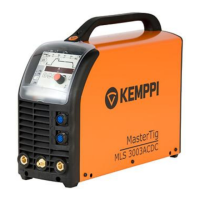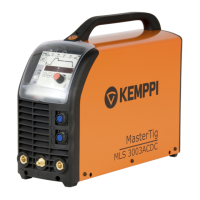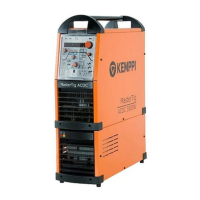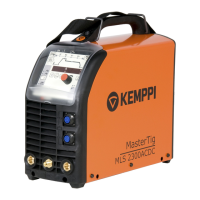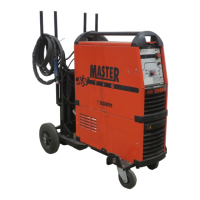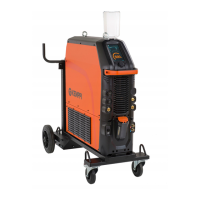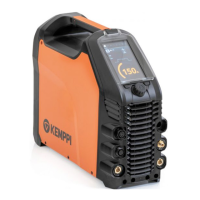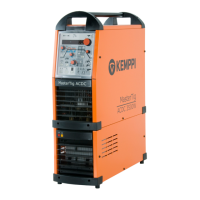
Do you have a question about the Kemppi MasterTig ACDC 3500W and is the answer not in the manual?
| Control Type | Digital |
|---|---|
| Power Supply | Mains |
| Input Voltage | 400 V |
| Output Current Range (TIG) | 5-350 A |
| Output Current Range (MMA) | 10-350 A |
| Welding Processes | TIG, MMA |
| Protection Class | IP23 |
General introduction to the welding equipment and operating manual.
Important notes and warnings to minimize damage and harm.
Connecting cables for MMA welding, return current, remote control, gas, and torch.
Guidelines for machine placement, mains connection, and power cable requirements.
Advice on welding torches, cables, grounding clamp usage, and cable lengths.
Compatible electrodes for DC and AC welding, including carbon arc gouging.
Using DC- current for steel welding and electrode sharpening techniques.
Using AC current for aluminum welding, recommending specific electrodes.
Explanation of AC balance for controlling heat between electrode and workpiece.
Handling gas bottles and installing regulators for shield gas connection.
Introduction to the machine's various control panels and their general purpose.
Detailed explanation of controls and functions on the BASIC panel.
Introduction to the MINILOG panel and its specific functions.
Detailed explanation of controls and functions on the ACDC Minilog panel.
Detailed explanation of controls and functions on the PULSE panel.
Explanation of numerical displays and signal lights on the machine panel.
Instructions for MMA welding, including current type selection and dynamics.
How to select TIG welding methods (HF, Contact) and current types.
Using spark and contact ignition methods for TIG welding.
Explains 2T and 4T torch switch operations for TIG welding.
How to adjust the down-slope time of the welding current using the potentiometer.
Steps and diagrams for 4T contact and spark ignition operations.
How to adjust the up-slope time of the welding current using the panel.
How to adjust pre-gas and post-gas times using the panel controls.
Adjusting arc form (BALANCE) and AC frequency for TIG AC welding.
Adjusting AC welding frequency using MINILOG and PULSE panels.
How to use Minilog operation for current adjustment and control.
How to operate Pulse welding using the pulse panel controls.
How to control start current (soft, normal, hot) for pulse welding.
How to perform fusion spot welding on the pulse panel.
Using memory functions to save and recall welding parameters and settings.
Steps to save current welding parameters to memory channels.
Securing the machine with a three-digit code for theft protection.
Information about the cooling unit, its operation, and liquid filling.
Overview of overheating, over-voltage, and torch protection systems.
Details on remote control units, foot pedals, and their connection/calibration.
Information about wheelbarrows and transport chassis for the machine.
Explanation of special jumper functions not visible on the panel.
Listing of factory default settings for various machine functions.
Checks and maintenance procedures for the welding torch and cable.
Daily checks for cables and periodic maintenance for the power source.
Services offered by KEMPPI Service Repair Shops for regular maintenance.
Guidance on contacting service for operation disturbances and troubleshooting.
Instructions for the proper disposal of electrical equipment according to regulations.
List of ordering numbers for machine parts, accessories, and cables.
